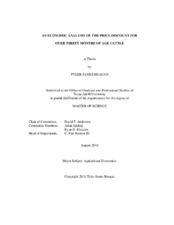| dc.description.abstract | On December 23, 2003, the first confirmed United States case of Bovine Spongiform Encephalopathy, or BSE, was discovered in Washington State. Four major importing countries of United States beef placed import bans on this beef immediately following the emergence of BSE. Since then all four countries have lifted the bans but placed restrictions of not importing beef from cattle over 30 months of age. As a result, cattle priced on formulas or on grids are discounted if older than 30 months. The purpose of this thesis is to analyze the impacts that economic factors have upon the over thirty month discount and the relative over thirty month discount.
Two models are run, a model showing how the economic factors effect 1) the discount and 2) the relative discount. Time series modeling using the ordinary least squares regression method is employed.
Economic factors, such as prices, supplies, United States beef exports, and export restrictions, are shown to affect the discount and relative discount for cattle over 30 months of age. Supplies have the largest impact on the discount and relative discount. As supplies increase the discount and relative discount increases. United States beef exports have the next largest impact on the discount and relative discount. An increase in exports to countries that maintain age restrictions will increase the discount and relative discount, while an increase in exports to countries without age restrictions will decrease the discount and relative discount. The reopening of beef trade between the United States and South Korea is found to cause the discount to grow.
This thesis found that as supplies increase or a higher percentage of United States beef exports are imported by countries with age restrictions on beef, the discount will increase, overall decreasing the value of these older cattle. If a higher percent of United States beef exports are imported by counties that do not have age restrictions, the discount will decrease and the value of these older cattle will increase. Overall, this thesis provides insight into the factors that change the discount for cattle over thirty months of age. | en |


